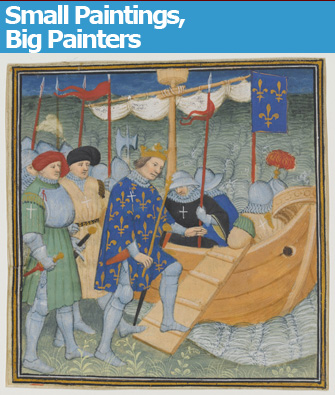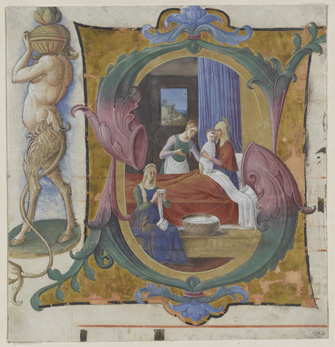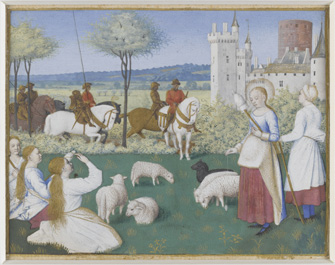 |
|
The Boucicaut Master’s “Departure of Louis IX for the Crusade.” © RMN /Thierry Le Mage |
Numerous acts of vandalism have made possible the Louvre’s exhibition “Medieval and Renaissance Illuminations: Painting on the Page,” as the medieval scholar who …
 |
|
The Boucicaut Master’s “Departure of Louis IX for the Crusade.” © RMN /Thierry Le Mage |
Numerous acts of vandalism have made possible the Louvre’s exhibition “Medieval and Renaissance Illuminations: Painting on the Page,” as the medieval scholar who accompanied me pointed out. On show are 70 illuminated pages from a variety of sources, representing one-half of the museum’s collection of such sheets, almost all of which were cruelly torn from the books or manuscripts they were once part of.
The show is necessarily a miscellany, with pages from French, Italian, Flemish and German historical, literary and liturgical sources, dating from the 11th to the 16th century. There is no lesson to be learned from the show – except that it is a crime to separate these pages from their original – and it is refreshing to be able for once to just feast one’s eyes on the sumptuous paintings and decorations without having to follow any curatorial theme.
The intense, jewel-like colors on these small paintings – many made with precious substances like gold, silver or lapis lazuli – leap off the page, as fresh as if they were daubed on yesterday.
Illuminators were not only often required to make miniature paintings that would still be perfectly clear and legible but also had to have a special talent for fitting their subjects into oddly shaped initial letters. Notice how beautifully the elongated figures of the Virgin and the angel Gabriel, each standing beneath a Gothic vault, fits into the confines of the capital in “The Annunciation” by the Sant’Eugenio Master (possibly Cola di Fuccio).
The initials themselves are often a marvel to behold, as in “The Birth of the Virgin” by Francesco Dai Libri, in which the tender birth scene – featuring a bedroom, four figures and a window opening onto a detailed landscape – is

surrounded by an elaborately decorated letter in gold, green, blue and pink, with a satyr carrying a large jar walking away from it on the left.
Works by many masters of the genre can be found in the show. The great Jean Fouquet (1420–1481) is represented by a few paintings, including a lovely pastoral scene from “Saint Martin Dividing His Cloak,” in which we see a

group of young shepherdesses spinning wool while tending their flock and watching the approach of a group of mounted soldiers.
Another stunner among many is the Boucicaut Master’s highly graphic “Departure of Louis IX for the Crusade” (pictured at top) with its beautiful composition; broad areas of blue, red and green; and detailed, realistic faces.
One can literally spend hours looking at these small gems, admiring the rich colors and the expertise of the calligraphers and painters, searching out the figures of humans and animals cunningly integrated into lavish decorative borders, and deciphering the stories told by the pictures.
Most of these little treasures, the majority of which were donated to the museum, have never been shown before, so don’t miss this rare opportunity to see them.
Musée du Louvre: Denon Wing. Métro: Palais-Royal-Musée du Louvre. Tel.: 01 40 20 53 17. Open Wednesday-Monday, 9am-6pm (until 10pm on Wednesday and Friday). Closed Tuesday. Admission: €10.00. Through October 10. www.louvre.fr
Reader Reaction: Click here to respond to this article (your response may be published on this page and is subject to editing).
Please support Paris Update by ordering books from Paris Update’s Amazon store at no extra cost. Click on your preferred Amazon location: U.K., France, U.S.
More reviews of Paris art shows.
© 2011 Paris Update
